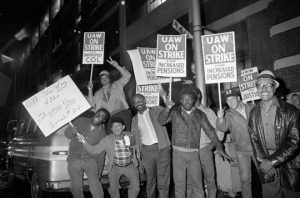This article first published 8/13/21 by the Minnesota Spokesman-Recorder https://spokesman-recorder.com/2021/08/13/july-job-report-plenty-of-jobs-but-for-low-wages/
There was good news and bad news in the July jobs report released by the Bureau of Labor Statistics on Friday. The good news is that employers added nearly one million jobs to their payrolls for the month; the bad news is that most of the jobs are bad.
It is a classic tale of two worlds. The addition of 943,000 jobs to nonfarm payrolls in July exceeded economists’ expectations by almost 75,000 jobs and represented the largest monthly increase in nearly a year.
In a Friday press conference, President Biden asserted that the jobs report was evidence that his administration had the U.S. economy on the right track. “What we’re doing is working,” he said.
Employees, on the other hand, are not impressed, African Americans least of all. Of the 943,000 jobs created in July, 380,000 were in the hospitality sector, where wages are notoriously low, and employers are often exempted from federal minimum wage laws, allowing them to pay as little as $2.13-per-hour to bartenders and wait staff who receive tips.
Devastated by the pandemic, bars and restaurants began reopening in the spring and since May, have accounted for 1.1 million new jobs, or 40% of all job growth nationwide.
That mirrors larger macroeconomic trends dating back to the Reagan White House, with each successive administration pursuing monetary, labor, tax and trade policies that discouraged capital investment in the manufacturing sector and its heavily unionized workforce.
What was once the most industrialized country in the world is now home to more maids, short-order cooks, and Amazon customer service reps than assembly-line workers.
Just a glance at the job openings in the Twin Cities proves the point: food servers, housekeepers, and customer service reps dominate the online help wanted ads, the vast majority of which pay less than $20-per-hour.
“People have to work three and four jobs to be able to pay the rent and eat,” said 66-year-old Lee Patterson, who is African American and an activist for affordable housing in Baltimore. Noting that the Amazon warehouse in the city pays most of its 2,300 employees an hourly wage of about $15-an-hour, Patterson says a worker fortunate to get 40 hours per week is going to clear $1,800-a-month after federal, state, and local taxes, leaving just enough to pay rent, food, and utilities.
“It’s hard to find a one-bedroom apartment in the city for less than $1,200 -a-month these days,” said Patterson. “You certainly won’t be able to afford a car, new or used, let alone put gas in it.”
Patterson’s math is consistent with the findings of a new monthly indicator that tracks the quality of jobs and not just the quantity. The US Private Sector Job Quality Index—or JQI—measures the ratio of what the researchers call “high-quality” versus “low-quality” jobs, based on whether the job pays more or less than the average income.
A reading of 100 means that there are equal numbers of the two groups, while anything less implies relatively lower-quality jobs. From a peak of about 95 in 1990, the JQI stood at about 82 last month, which means that the economy is churning out roughly 82 jobs that pay decently, for every 100 that don’t.
Poor quality jobs, especially in the fast-food industry, are attracting a younger workforce with little job experience and fewer options. The Bureau of Labor Statistics reports that the unemployment rate for teenagers between the ages of 16 and 19 dropped below 10% for the first time since 1956.
While the mainstream media has celebrated this development as positive, there is growing evidence that stressful workplace conditions in the industry are beginning to impact the number of employees willing to work so hard for so little pay.
Last month, the entire staff of a Burger King in Lincoln, Nebraska, walked off the job after posting a sign that read “We all quit” and “Sorry for the inconvenience.” Similarly, Sophia Cargill, the African American general manager in training at a Wendy’s restaurant in Kalamazoo, Michigan, recorded a White assistant manager named Michael yelling insults at her and repeatedly calling her a b—-.
When Cargill reported the incident, company executives initially suspended her for two weeks without pay, although when the videotape of the incident went viral, the company fired the White assistant manager and offered Cargill her job back; on social media she said she had declined.
In fact, workers have been leaving jobs in restaurants, bars, and hotels at the highest rate in decades. Nearly 5% of the industry’s workforce has quit their job each month of this year, including 706,000 fast-food employees in May alone.
More than a million jobs in the sector remain unfilled, forcing employers to raise wages. Brands such as Chipotle, Olive Garden, White Castle, even McDonald’s, are now offering entry-level pay between $11 and $17 an hour, paying people just to show up for interviews, adding signing bonuses, and recruiting young workers on TikTok.
In May of this year, the average hourly pay for nonmanagers in the hospitality industry surpassed $15 for the first time in May.
Still, that is not enough for everyone. While surveys indicate that low wages are the most common reason cited by employees for quitting their jobs, in one recent survey, more than half of hospitality workers who’ve quit their jobs said that the workplace was so stressful that no amount of pay would get them to return.
Said Patterson: “Man, most of these jobs don’t pay enough for you to buy toilet paper.”





No comment yet, add your voice below!